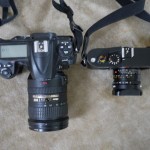Costco Hawaii kai has some nice leather couches to relax in while waiting for their one-hour photo to do my development (c-41) and scans (noritsu) of 35mm film. I normally carry my iPad2 and/or nook simple touch with a pair of etymotics hf3 to pass the time. This is forced but relaxing down time in a pleasant, partial skylit, a/c environment. It is a privilege of belonging to the peoples’ club.
Later I will pay less than $5 for the service, take my DVD home or Barnes & Noble that has free wifi, and review the scans on my macbookpro using Aperture. I generally don’t do any mods on the scans as they’ve been consistenty good on overall balance. Maybe out of a 36-exposure film roll, I might average two or three keepers that I’d upload to Facebook and/or flickr.
Then a bit of house keeping. The negs go into a file cabinet, envelop and all, as-is from Costco, in chronological order. And the digital photo files are stored on a portable hard drive, and backed up by Timemachine – a free Apple application that comes with the O/S- and still larger hard drive.
One thing about this workflow is that I have to apply myself is to consistently and better categorize all my photos on Aperture and Flickr. It appears that the metadata entered in Aperture does not get uploaded with Flickr.
Looks like time to walk over from my couch to the Costco photo counter…. Stopped by Longs Hawaii kai to redo the scans to compare their fuji scanner against costco’s noritsu. Results from the fuji will take overnight in-store and be ready tomorrow by noon, but I’ll drop by later after work.




